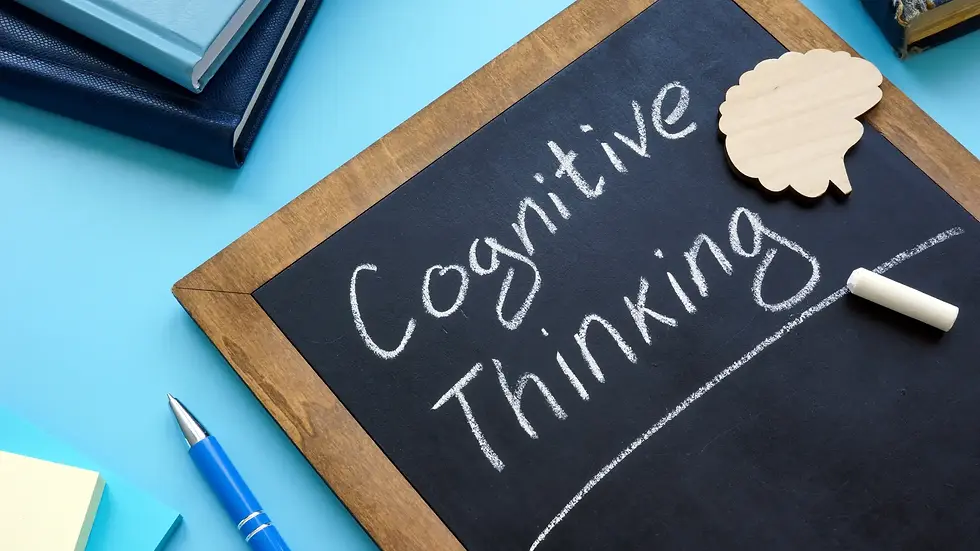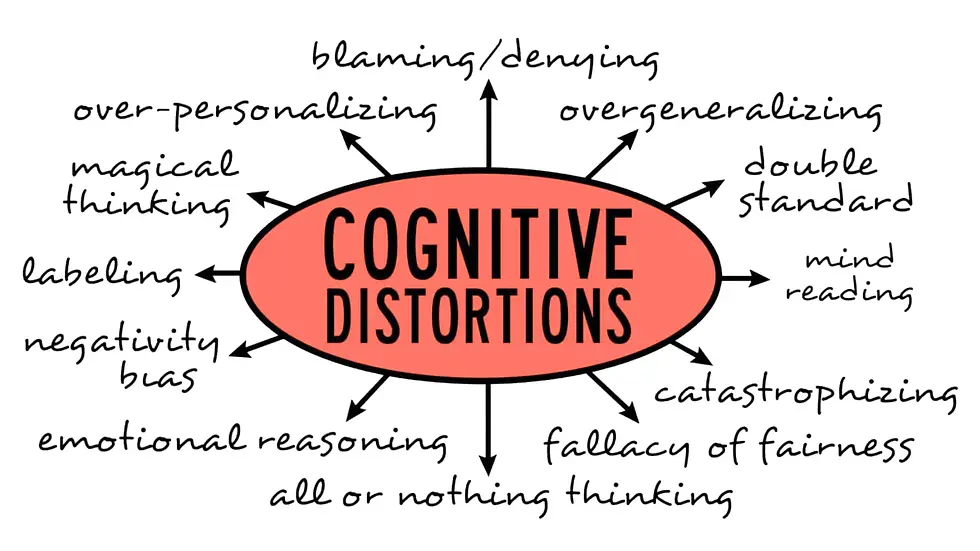Cognitive Distortions
- Ann Maria Thomson

- Aug 9
- 4 min read
Updated: Aug 14
Cognitive Behavioral Therapy is one of the fundamental therapeutic techniques used by psychologists to help individuals deal with different kinds of mental health disorders, such as depression, PTSD, and many others. Aaron T. Beck developed CBT, or Cognitive Behavioral Therapy, with several others modifying this technique into the present therapeutic technique used by professionals.

The center of Cognitive Behavioral Therapy is cognitive distortions. CBT is a technique used to identify and challenge these cognitive distortions.
Beck defined cognitive distortions as the faulty beliefs and perspectives we have about ourselves and/or the world around us. These irrational thoughts and biases are automatic and often reinforced over time. This can lead to increased emotional distress, negatively impact behavior and well-being, and lead to mental health disorders.
What causes Cognitive Distortions?
Several reasons can be potential reasons for cognitive distortions:
Evolution-
Our ancestors constantly lived in ‘fight or flight mode’. The fear they felt was a survival mechanism that alerted them to potential dangers in their environment. While the time of our ancestors was unpredictable and dangerous, the world we live in is not the same as theirs. In the modern world, we don’t have to be constantly alerted to changes in our environment. The amygdala, a tiny structure in the brain, is responsible for emotions like fear and aggression. Cognitive distortions occur when the amygdala overreacts to stimuli in your surroundings.
Negativity-
A person's perceived negativity leads to perceiving situations through a negative lens, resulting in negative bias and mental health issues.
Chemical Imbalances-
Changes in the neurotransmitters in the brain, such as dopamine and serotonin, can also lead to cognitive distortions.
Trauma-
Traumatic experiences can significantly impair the thinking process, causing the individual to focus on the negative aspects instead of the positive side.
Social media-
Life without social media is incomplete. Constantly engaging in negative and disturbing online content can also lead to cognitive distortion.
Nearly everyone experiences cognitive distortions. For some, these thoughts may be mild, while for some, they can be extreme. Cognitive distortions cause individuals to misinterpret situations or view situations more negatively based on bias rather than evidence. Frequent or extreme distortions can contribute to issues such as anxiety, depression, and low self-esteem.
Types of Cognitive Distortions

Cognitive distortions fall under four main categories. They are:
1. Self-centered
2. Blaming others
3. Minimizing and mislabeling
4. Assuming the worst
Let’s explore these categories in depth with examples
1. Self-Centered
These cognitive distortions involve extreme thinking.
All-or-Nothing Thinking
Also known as Black-and-White Thinking, these distortions involve viewing situations as either entirely black (all bad) or entirely white (all good), with no middle ground or gray area.
Example: "If I don't get an A+ for all the subjects in 10th boards, I'm a total failure."
Mind Reading
As the name suggests, mind-reading distortion causes individuals to assume what others are thinking negatively, with no concrete evidence.
Example: “She didn’t text me today, she hates me.”
‘Should’ Statements
These distortions involve restricting oneself and others by rigid rules. Should statements often lead to unrealistic expectations and negative feelings, such as shame, guilt, and a sense of failure.
Example: “I should say ‘yes’ to everything my friends say.”
2. Blaming Others
Every time something goes wrong, the individual puts the blame on others.
Control Fallacies
Control fallacies can be of two kinds. It is the constant belief that you have no control over a situation, or it is the belief that everything is your fault.
Example: "My relationship failed, I’m solely responsible for it.” or “My relationship failed, it is entirely my partner’s fault.”
3. Minimization and Mislabeling
Ignoring positive thoughts and placing extreme emphasis on negative thoughts.
Magnification or Minimization
They either exaggerate the negatives or minimize the positives. Catastrophizing is a form of magnification where they expect the worst, without any evidence.
Example: "My tiny mistake in the exam made me lose an A+ grade. I will never be successful in my life.”
Labeling and Mislabeling
Labeling refers to assigning global labels to oneself or others, while mislabeling refers to inaccurate labels based on a single incident or experience.
Example: “I’m an idiot. I couldn’t win the competition," or “I failed this test, so I’m a loser."
4. Assuming the worst
This is often common among patients with mental health conditions.
Overgeneralization
Individuals draw negative conclusions from a single event or experience.
Example: "The interview didn’t go as expected; I’ll never get a job."
Emotional Reasoning
They strongly believe that their negative feelings are the reality.
Example: "I feel like a failure; I am a failure."
Mental Filtering
Excessive focus on the negative details and ignoring the positives.
Example: "Everyone appreciated the presentation, but I can only think about how I mispronounced a word in the slide.”
Disqualifying the Positive
They have a belief that positive experiences do not matter.
Example: "She complimented my outfit today, but she was just being nice."
Personalization
Constant self-blame or blaming oneself for situations that happen outside of one's control.
Example: "My parents fought; it must be because of something I did."

Cognitive Distortions can significantly impair your mental health, resulting in reduced overall well-being. Suppose you’re someone who constantly engages in any of these irrational thinking patterns mentioned above. In that case, it is necessary to break down the cycle of negative thoughts and embrace a positive self. Here are a few techniques to help you out:
Be aware of when these distortions occur and in which situations they happen.
Journal these distortions. This helps you to keep track of the frequency and severity of these thoughts.
Look for evidence. Search for evidence that supports your thoughts. If you don’t find them, it is a sign that you need to change that belief.
Learn to reframe your thoughts. Instead of saying, “I failed the test... I will never pass this subject”, say to yourself, “I failed this time, but next time I will work hard to pass in this subject.”
Despite these self-help strategies, if you find yourself struggling with your thoughts and beliefs, you can seek professional help. A psychologist can use Cognitive Behavioral Therapy and other techniques to change your thinking patterns, leading to positive thoughts and beliefs. You must seek help early on, as repeated indulgence in negative thinking patterns can damage your emotional well-being.
Your thoughts don’t have to trouble you anymore………..
Book your session with Koott today.








Comments